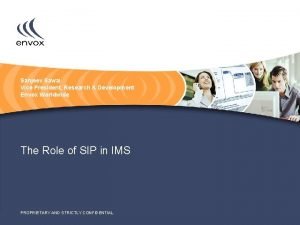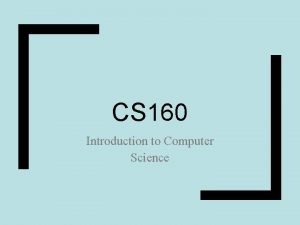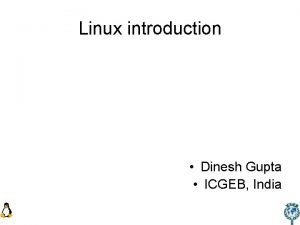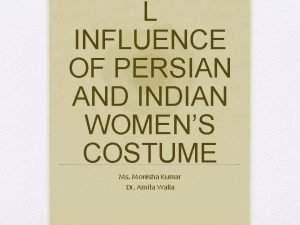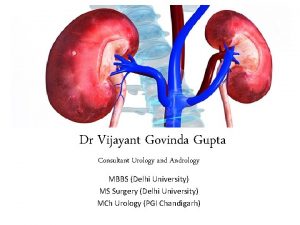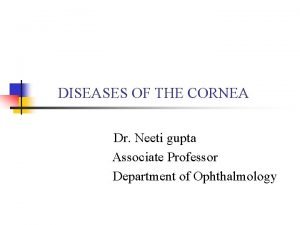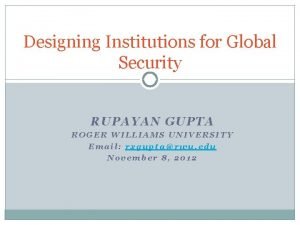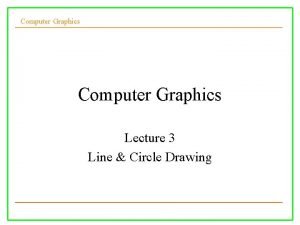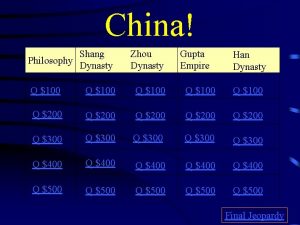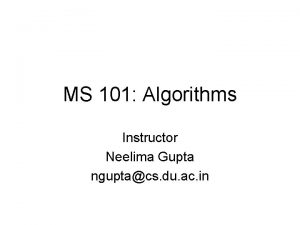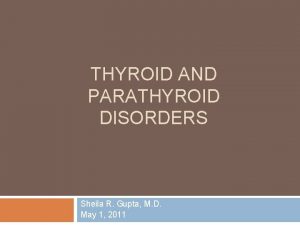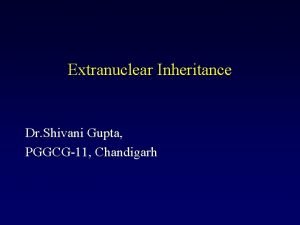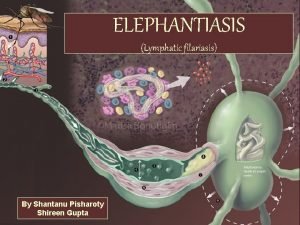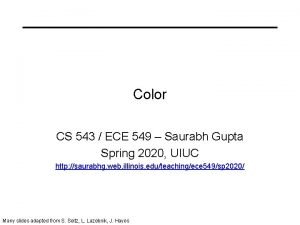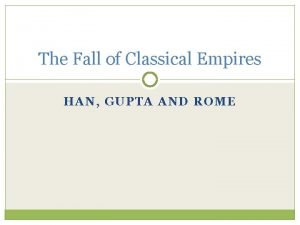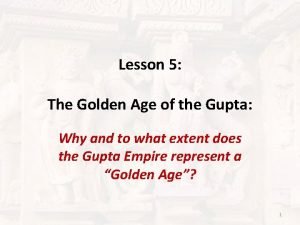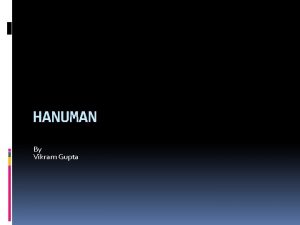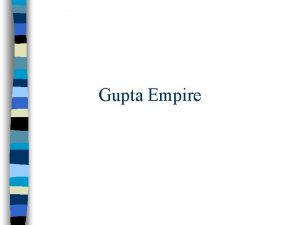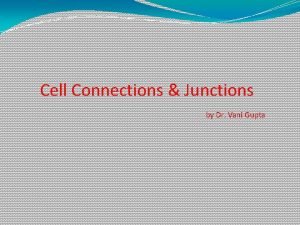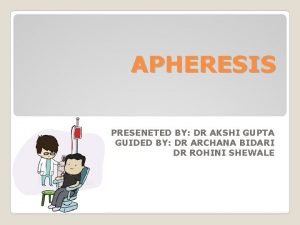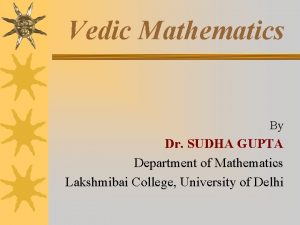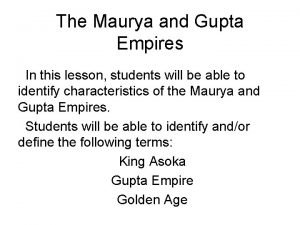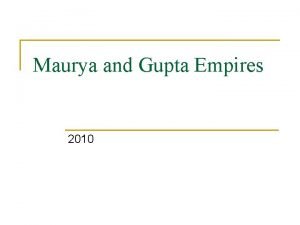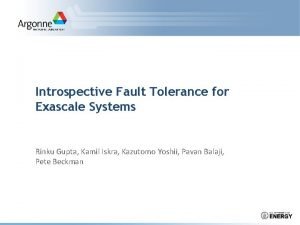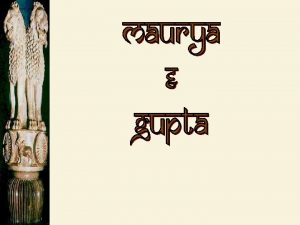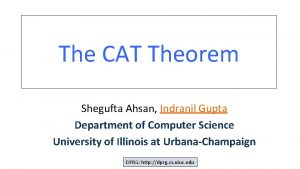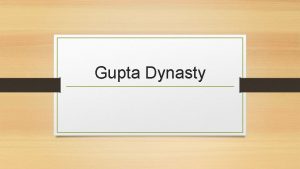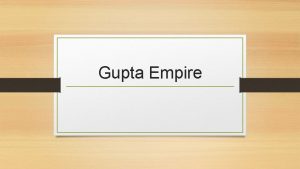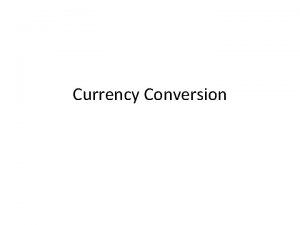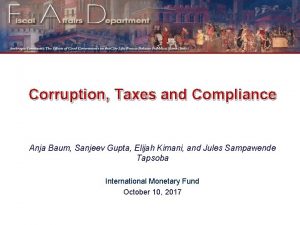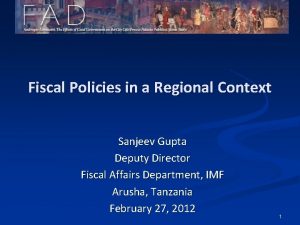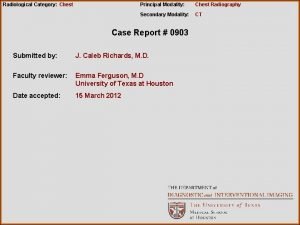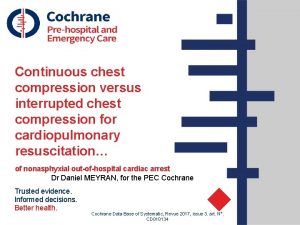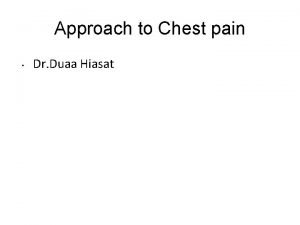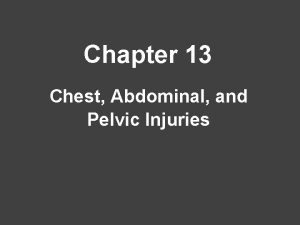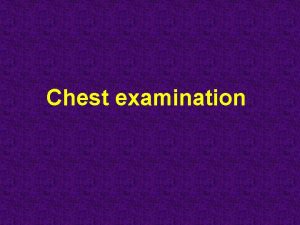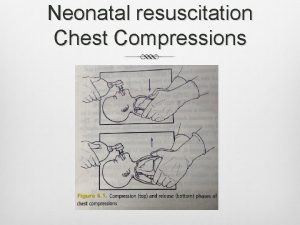Management of currency Currency Chest Mechanism Sanjeev Gupta









































































- Slides: 73

Management of currency & Currency Chest Mechanism Sanjeev Gupta Manager Issue Department, New Delhi

Meaning Importance and legal Provisions �Introduction Currency Management is one of the traditional central banking functions. It was the main reason for establishing RBI. (As per Section 3 of RBI Act)

� What is Management? � Planning � Organising � Controlling

What is Currency? � Notes � Coins

What is the Meaning of Currency Management? �Legal Framework �Infrastructure �Estimate - How? �Indent �Issue �Withdraw �Destroy �Reserve Management �Design �R&D �Technology �Customer Service �Counterfeiting �Public Awareness �Coordination

Legal Provisions Currency �Notes �Currency Note (1 Re Note) issued under Currency Ordinance 1940 – treated as Rupee Coin �Bank Note (Rs. 2 and above) �Coins (Indian Coinage Act, 1906) �Rupee coins (≥ Re. 1) �Small coins (< Re. 1) – only 50 p. 6

Legal tender of coins Less than Rupee 1………………Rs. 10/Rupee 1 and above………………Rs. 1000/�Government of India has �Sole right to mint coins �Responsibility on coinage �Designing and minting of coins 7

India Government Mints - 4 �Mumbai �Alipore (Kolkata) �Saifabad (Hyderabad) �NOIDA (UP) PREAMBLE TO RBI ACT �TO REGULATE THE ISSUE OF BANK NOTES and �THE KEEPING OF RESERVES WITH A VIEW TO SECURING MONETARY STABILITY IN INDIA and �GENERALLY TO OPERATE THE CURRENCY & CREDIT SYSTEM OF THE COUNTRY TO ITS ADVANTAGE � 8

CURRENCY MANAGEMENT 1. Issue of notes/ coins 2. Making available note and coins of required denomination 3. Ensure quality of notes in circulation 4. Settlement of claims against defective, mutilated etc. Notes 5. Maintenance of reserve for note issue

NOTE ISSUE �SECTION 17 (Business which the Bank may transact) �Sub - Section (15) �BANK SHALL MAKE AND ISSUE BANK NOTES �SUBJECT TO PROVISIONS OF THE ACT {FIRST ISSUE OF BANK NOTES IN JANUARY 1938 - RS 5, RS 10}

SECTION 22 � SUB SECTION 1: �BANK SHALL HAVE THE SOLE RIGHT TO ISSUE BANK NOTES IN INDIA

SECTION 23 �SUB-SECTION 1 �ORGANISATIONAL SET UP OF ISSUE DEPARTMENT �SHALL BE SEPARATE �DISTINCT �ASSETS FROM BANKING DEPT. . OF ID NOT TO BE SUBJECTED TO ANY LIABILITIES OTHER THAN THE LIABILITIES OF ID

SECTION 23 �SUB-SECTION 2 �ISSUE OF NOTES TO BKG DEPTT OR TO ANY OTHER PERSON ONLY IN EXCHANGE FOR �OTHER BANK NOTES �COIN BULLION, SECURITIES AS PERMITTED BY THE ACT TO FORM A PART OF THE RESERVE

SECTION 24 �SUB-SECTION 1 �DENOMINATION OF BANK NOTES (2, 5, 10, 20, 50, 100, 500, 1000, 5000, & 10000) �OR SUCH OTHER DENOMINATION AS THE CG ON RECOMMENDATION OF CB MAY SPECIFY �CONTD…. .

SECTION 24 �SUB-SECTION 2 �CENTRAL GOVT. ON RECOMMENDATION OF THE CENTRAL BOARD MAY DIRECT �NON-ISSUE OR �DISCONTINUANCE OF ISSUE OF BANK NOTE OF ANY DENOMINATIONAL VALUE

SECTION 25 �DESIGN �FORM �MATERIAL OF BANK NOTES �APPROVED BY CENTRAL GOVT AFTER CONSIDERATION OF THE RECOMMENDATION OF CENTRAL BOARD

SECTION 26 �SUB - SECTION 1 � Every Bank Note Is Legal Tender At Any Place In India & Shall Be Guaranteed By CG Subject To The Prov. Of Sub-section 2 �SUB-SECTION 2 � ANY SERIES � ANY DENOMINATION � CEASES TO BE LEGAL TENDER � FROM SUCH DATE SPECIFIED � IN THE GAZETTE � BY CENTRAL GOVERNMENT ON RECOMMENDATION OF THE CENTRAL BOARD

SECTION 27 � BANK SHALL NOT REISSUE �TORN �DEFACED �EXCESSIVELY SOILED NOTE

SECTION 28 �NO PERSON SHALL HAVE THE RIGHT TO �RECOVER FROM CG / BANK VALUE OF ANY �LOST �STOLEN �MUTILATED OR �IMPERFECT CURRENCY / BANK NOTES

SECTION 28 �BANK MAY WITH PREVIOUS SANCTION OF CG PRESCRIBE �CIRCUMSTANCES IN & �CONDITIONS SUBJECT TO WHICH �VALUE OF SUCH NOTE IS REFUNDED AS A MATTER OF GRACE

SECTION 29 �BANK NOT LIABLE TO PAY STAMP DUTY ON BANK NOTES �UNDER INDIAN STAMP ACT 1899

BALANCE SHEET AS ON 30 TH JUNE 2012 ISSUE DEPARTMENT RUPEES IN THOUSAND LIABILITIES NOTES HELD IN BD ASSETS 89, 169 NOTES IN CIRCULATION GOLD COIN & BULLION (a) HELD IN INDIA 11034, 645, 327 (b) HELD OUTSIDE INDIA TOTAL NOTES ISSUED 11034, 734, 496 FOREIGN SECURITIES 10261, 966, 851 RUPEE COINS 2, 206, 548 RUPEE SECURITIES 1046, 43, 00 PROMISSORY NOTES & BILLS OF EXCHANGE TOTAL 11034, 734, 496 760, 096, 797 ----------- 11034, 734, 496

Section 33(1) – ASSETS OF I. D. �Gold coin, �Gold bullion, �Foreign securities, �Rupee coin �Rupee securities �Certain eligible bills* * In practice such bills have not figured as assets of ID. However NABARD p/n under sec 17(4 e) of RBI Act may be held as an asset.

Section 33(2) �The total of gold and foreign securities held should not be less than Rs. 200 crores �Gold value being not less than Rs. 115 crores

Section 33(3) �The balance of the assets will be in the form of rupees coin, Go. I rupee securities of any maturity and eligible bills of exchange

Section 33(4) �The valuation of assets � 1) gold is valued at the end of the month at 90% of the daily avg price quoted at London for the month (w. e. f. 1 st Oct 1990) � 2)Re equivalent is determined on the basis of exc rate prevailing on the last business day of the month �Gains / losses are adjusted to CGRA �Rupee coin at face value

Section 33(5) �Of the gold coin & gold bullion held as assets, not less than 17/20 th shall be held in India, in the custody of the bank or its agencies �Provided that gold belonging to the bank which is in any other bank or any / treasury mint or in transit be reckoned as part of the assets

FOREIGN SECURITIES : ----- Sec. 33(6) FOREIGN SECURITIES CONSISTS OF : --- v BALANCES WITH OVERSEAS CENTRAL BANKS v BALANCES WITH IMF, IBRD, IDA, IFC, ADB, BIS, ETC. v SECURITIES ISSUED BY IMF, IBRD, IDA, IFC, ADB, BIS ETC. v FOREIGN GOVT. SECURITIES MATURING WITHIN 10 YEARS. CONTD……….

FOREIGN SECURITIES ---- VALUATION FOREIGN SECURITIES: ---- 1. AT MARKET PRICE 2. APPERICIATION IGNORED 3. DEPRECIATION PROVIDED

RUPEE COIN : ---RUPEE COIN CONSISTS OF : --ONE RUPEE NOTES RUPEE COINS – 1, 2, 5, 10 SPECIAL ISSUE OF COINS IN HIGHER DENOMINATIONS NOTE: ---- SMALL COINS ( 50 PAISE & BELOW) ARE NOT RUPEE COIN & HENCE NOT ASSET

RUPEE SECURITIES CONSISTS OF : ----- q GOVT. SECURITIES OF ANY MATURITY q SPECIAL SECURITIES (oil bonds, Food Corporation of India bonds, fertiliser bonds, power bonds, etc ) & TREASURY BILLS q PRIOR TO 1997 – AD HOC TREASURY BILLS

RUPEE SECURITIES VALUATION Ø AT LOWER OF BOOK VALUE OR MARKET VALUE Ø APPRECIATION NOT ACCOUNTED FOR Ø DEPRECIATION ADJUSTED AGAINST CURRENT INCOME

Currency account (for notes other than one rupee notes) Notes Stock account (General stock of notes other than those held under the other heads mentioned below) Exchange Notes account (box balance) Chest Notes account (chest balances) Circulation Notes account (Notes in circulation) Invoiced Notes account (notes received from chests and other offices and awaiting disposal) Guarantee Notes account (notes tendered by banks and others and held pending examination at a later date) Reissuable Notes account (Reissuable notes held in stock) Retired Notes account (Examined notes collected after examination/processing and held in the retired notes vault before being written off under warrant cum destruction certificate)

SECTION 34 �LIABILITY OF ISSUE DEPARTMENT �TOTAL AMOUNT OF CURRENCY NOTES OF GOVT. �TOTAL AMOUNT OF BANK NOTES IN CIRCULATION

SECTION 38 �OBLIGATION OF GOVT. & THE BANK TO SUPPLY DIFFERENT FORMS OF CURRENCY �CG SHALL NOT UNDERTAKE TO PUT INTO CIRCULATION ANY RUPEES EXCEPT THROUGH THE BANK �BANK SHALL UNDER TAKE NOT TO DISPOSE OF RUPEE COIN OTHERWISE THAN FOR THE PURPOSE OF CIRCULATION

SECTION 39(1) �OBLIGATION TO SUPPLY DIFFERENT FORMS OF CURRENCY �BANK SHALL ISSUE RUPEE COINS ON DEMAND �IN EXCHANGE OF BANK NOTES/ CURRENCY NOTES �SHALL ISSUE CURRENCY NOTES IN EXCHANGE FOR �COINS WHICH ARE LEGAL TENDERS

SECTION 39(2) �BANK SHALL IN EXCHANGE FOR �CURRENCY NOTES �BANK NOTES �SUPPLY �BANK NOTES �CURRENCY NOTES OF LOWER DENOMINATION OR OTHER COINS WHICH ARE LEGAL TENDER �QUANTITIES -DECIDED BY THE BANK - REQUIRED FOR THE PURPOSE OF CIRCULATION

SECTION 39(2) �CENTRAL GOVT SHALL SUPPLY SUCH COINS TO THE BANK ON DEMAND �IN CASE OF FAILURE ON THE PART OF CG TO SUPPLY - BANK IS RELEASED FROM THE OBLIGATION

Section 53 �The bank is required to prepare and transmit a weekly statement of account of the issue department (also banking deptt) in the prescribed form to Go. I. �It also required to prepare and transmit annual accounts of the bank within 2 months from the date of annual closing.

Section 58(2) (q) �The bank will have power to make regulations with the approval of the Go. I for payment of value in respect of lost, stolen, mutilated or imperfect bank notes. � Note refund rules have been framed under this provision read with Section 28.








Clean Note Policy सवचछ न ट न त

RBI Act, 1934 - Section 27 �The Bank shall not reissue bank notes which are torn, defaced or excessively soiled. �Announced by RBI Governor in 1999. �Ensure "adequate, good quality clean notes are available throughout the country".

Clean Note Policy – Two Aspects �Supply �Withdrawal

Steps to implement Clean Note Policy �Modernisation of existing banknote printing presses and the mints �BRBNMPL set up on February 03, 1995. Two banknote printing presses commenced production from June 01, 1996 and December 11, 1996, respectively.

Steps to implement Clean Note Policy �Mechanisation – CVPS, SBS, CVM, NSM �Stop Stapling of notes – Directive – November 2001 �Coinisation �Polymer Notes �Special Drives �ICCOMS �Incentive and Penalty �CPCs

Public Awareness �Not to staple the banknotes �Not to write / put rubber stamp or any other mark on the banknotes �Store the banknotes safely to prevent any damage

CURRENCY CHEST MECHANISM Sec. 39 (2) of RBI Act, 1934 RBI shall in exchange for notes of two rupees or upwards, supply notes of lower value or other coins which are legal tender in such quantities as may be required for circulation. So, the responsibility for proper and efficient distribution of notes within the circle rests with the Issue Department of the circle.

CURRENCY CHESTS • Nothing but strong rooms where stocks of fresh, reissuable, soiled notes and rupee coins are stored. • The currency chests are extensions of issue department and may be regarded as receptacles. • Mini-issue departments 9/6/2021 Issue Accounting 55

OPERATIONS IN Cy. CHESTS Deposit of bank notes - reduction in notes in circulation Withdrawal of bank notes- increase in notes in circulation Deposit of rupee coin-Increase in Assets of Issue Dept Withdrawal of rupee coin- reduction in Assets of Issue Department 9/6/2021 Issue Accounting 56

CURRENCY CHEST MECHANISM �Currency chests are nothing but strong rooms at the appointed branches of the banks. �In these strong rooms, stocks of fresh, reissuables and also soiled bank notes are stored. In other words, the currency chests are extensions of Issue Office. �The bank notes and Rupee coins held in currency chest are, therefore, the property of Issue Department.

CURRENCY CHEST MECHANISM Purposes for opening the currency chests: 1. To meet the currency requirements of the public 2. To maintain the quality of currency in circulation by withdrawing unfit notes 3. To afford exchange facilities of one denomination into another. 4. To meet the payments of Governments/banks/public.

CURRENCY CHEST MECHANISM Purposes for opening the currency chests: � 5. To operate remittance facilities conveniently � 6. To arrange for exchange of mutilated and other notes as per Note Refund Rules � 7. To obviate the necessity of physical transfer of cash from one place to another at frequent intervals and � 8. To enable the banks to work with minimum cash balance of their own. 59

CURRENCY CHEST MECHANISM How it works? �The bank notes printed at Nashik, Dewas, and the BRBNMPL presses at Mysore and Salboni are first sent to the Issue Departments at headquarters of 19 Issue Circles. �Then from each Issue Department, they are remitted to individual currency chests. �From the Issue Departments and Currency chests, the notes are issued to public and the total notes issued thus to public are the liabilities of Issue Department. 60

CURRENCY CHEST MECHANISM �The notes and coins are put into circulation through: � 20 Issue Offices of RBI(including One sub-office at Lucknow and one currency chest of RBI at Kochi) � 4221 currency chests � 4018 SCDs 61

CURRENCY CHEST MECHANISM �In terms of Section 33 of RBI Act, Rupee coin stocked in Issue Department and currency chests are one of the eligible assets that can be held as backing for note issue, since Rupee coins are issued by Government of India. �So long as Rupee coins are held in Issue Department (including currency chests) they form a part of the eligible assets. The moment they are issued to public, the assets of the Issue Department get depleted. �As Rupee coins are issued on behalf of Government of India, the liability of Issue Department does not go up as in the case of their issue to public.

CURRENCY CHEST MECHANISM �The minimum amount of currency transfer in bank notes are Rs. 1, 000 and in multiples of Rs. 50, 000. �Besides, there may be Remittances between Currency chests on account of diversion orders issued by Issue Office or Fresh notes Remittances arranged from Issue Offices and remittances of soiled notes from Currency chests to Issue Office. These remittances within the Circle do not alter the Chest Notes balances. �Remittances to and from other Issue Circles will affect the balances.

CURRENCY CHEST MECHANISM Opposite transfer As per section 23 �Issue Department is to be kept distinct from the Banking Department. �The assets of Issue Department are not subject to any other liability excepting its own viz. bank notes in circulation. �On account of currency transfer transactions taking place at Chests the equilibrium of assets and liabilities of Issue Department gets affected. �In order to comply with section 33, we have to bring back to equilibrium either by adjusting our assets position or liability position.

CURRENCY CHEST MECHANISM How accounting of opposite transfers is done? 1) The currency chest will report the currency transfer transactions through ICCOMS (Integrated Computerised Currency Operations & Management System) to their respective Link Office located in the headquarters of Issue Department. 2) The Link Office will consolidate the figures and submit it to the Accounts Section of Issue Department daily. However, the Link Office statement will contain the transactions of the previous day through ICCOMS. 3) When the banks withdraw bank notes/ Rupee coins, they have to pay equivalent amount. This is done at the headquarters of issue circle by debit to the current account of bank concerned with DAD.

CURRENCY CHEST MECHANISM Accounting of Opposite Transfer: �Let us suppose that there has been a net withdrawal at currency chests of SBI branches to the extent of Rs. 25 crore. The opposite transfer for this transaction is from Banking Department to Issue Department. �In Banking Department, the current account of SBI will be debited and equivalent amount accounted as payable to Issue Department. �In case of net deposits at currency chests, the opposite transfer will be from Issue Department to Banking Department. The Current account of the bank concerned will be credited.

CURRENCY CHEST MECHANISM �The reporting of currency transfer transaction is required to reach the Accounts Section on the same day i. e. up to 9. 00 PM by the Currency Chests and upto 11. 00 PM by the Link Office. �RBI charges penal interest at the rate of Bank rate + 2% on delayed reporting/ wrong reporting/non-reporting.

CURRENCY CHEST MECHANISM �The Banking Department is also required to put through transactions with commercial banks, government and other institutions for payments to employees and transactions under Remittance Facilities Scheme. �During the day, there may be net payment or receipt. �If there is net payment, Banking Department will draw bank notes from Issue Department. If it has surplus cash over and above their minimum cash balance (each DAD has been assigned a minimum cash balance depending on their volume of transactions) they will transfer the surplus bank notes to Issue Department. �These cash receipts/transfers in bank notes will again affect the equilibrium of assets and liability of Issue Department and the equilibrium is brought about by adjustment of eligible assets (Rupee securities and foreign securities) at DGBA, Central office.

CURRENCY CHEST MECHANISM �If there is a net withdrawal from Issue Department, say by Rs 25 crore, then the liability of Issue Department will go up. Eligible rupee securities or foreign securities equivalent of Rs. 25 crore would be transferred from Banking Department to Issue Department. �On the other hand, if there is a net transfer of surplus bank notes from Banking Department to Issue Department, the above assets will be transferred from Issue Department to Banking Department.

CURRENCY CHEST MECHANISM Therefore, every transfer at currency chest will have an opposite transfer at RBI as under: �The equilibrium of assets and liabilities in respect of currency transfer transactions of currency chests is brought about by adjusting liability side at the headquarters of each issue circle by opposite transfer, i. e. transfer of bank notes from Issue Department to Banking Department or vice versa. � However in respect of the withdrawal/transfer of bank notes by Banking Department in adjustment of their cash balance, the change in assets and liabilities of Issue Department is off set by adjustment of assets at Central office DGBA.

Small Coin Depots �Coins of 50 paise and lower denominations are known as small coins. These coins are the property of the Government of India and they are issued by Reserve Bank of India on behalf of the Government of India. Small coins are stored in Small Coin Depots which are established at Treasuries/sub. Treasuries/branches of Public Sector Banks. The small coin depots are mostly housed along with currency chests in separate bin/ cup boards but accounted separately.

Small Coin Depots �Since the balances held in the Small Coin Depots are the property of the Central Government, any withdrawal there from will have to be off-set by affording credit to the Government account while any deposits made thereat would result in a debit to the Government account.

Thank You
 Dr sanjeev chatni
Dr sanjeev chatni Sanjeev sawai
Sanjeev sawai Dr. sanjeev mehrotra
Dr. sanjeev mehrotra Sanjeev khemani
Sanjeev khemani Ringgord
Ringgord Chest tube sizes
Chest tube sizes Chest tube management powerpoint
Chest tube management powerpoint Anjula gupta
Anjula gupta Shambhu gupta & co
Shambhu gupta & co Kinseyprivate
Kinseyprivate Dr himanshu gupta
Dr himanshu gupta Shankar gupta
Shankar gupta Anjum gupta ucsd
Anjum gupta ucsd Dinesh gupta icgeb
Dinesh gupta icgeb Persian
Persian K+k
K+k Dr sonal gupta
Dr sonal gupta Dr vg gupta surgeon
Dr vg gupta surgeon Navin gupta md
Navin gupta md Neeti gupta
Neeti gupta Rupayan gupta
Rupayan gupta Midpoint line drawing algorithm in computer graphics
Midpoint line drawing algorithm in computer graphics Gupta empire philosophy
Gupta empire philosophy Amritdhara pharmacy v. satyadeo gupta
Amritdhara pharmacy v. satyadeo gupta Aseem gupta adq
Aseem gupta adq Kavita gupta md
Kavita gupta md Fag bearings india limited
Fag bearings india limited Dr pulin kumar
Dr pulin kumar Vclab odu
Vclab odu Dr vani gupta
Dr vani gupta Sandhya gupta
Sandhya gupta Amit gupta microsoft
Amit gupta microsoft Advantages of surface computing
Advantages of surface computing Sheila gupta
Sheila gupta Kapila gupta
Kapila gupta Dr gupta stepping hill hospital
Dr gupta stepping hill hospital Gupta sculpture
Gupta sculpture Shivani gupta sex
Shivani gupta sex Shireen gupta
Shireen gupta Clamshell packaging design
Clamshell packaging design Harsh gupta md
Harsh gupta md Saurabh gupta uiuc
Saurabh gupta uiuc Han gupta
Han gupta Sachin gupta md
Sachin gupta md Gupta
Gupta P-cp
P-cp Write the narration for gupta
Write the narration for gupta Chronology of gupta dynasty
Chronology of gupta dynasty Prof. dr. pradeep kumar gupta
Prof. dr. pradeep kumar gupta Pylomyotomy
Pylomyotomy Vikram gupta md
Vikram gupta md Tradensea
Tradensea Gupta empire trade routes
Gupta empire trade routes Vaani gupta
Vaani gupta Navin gupta md
Navin gupta md Sunil gupta actor
Sunil gupta actor Varna gupta
Varna gupta Gupta outsourced
Gupta outsourced Gupta definition
Gupta definition Dr uma gupta
Dr uma gupta Preseneted
Preseneted 7cs of communication clarity
7cs of communication clarity Dr sudha gupta
Dr sudha gupta The maurya and gupta empires
The maurya and gupta empires The maurya and gupta empires
The maurya and gupta empires Aarti gupta md
Aarti gupta md Chandragupta maurya ruled for _____years.
Chandragupta maurya ruled for _____years. Kamil gupta
Kamil gupta Dr vani gupta
Dr vani gupta Gupta sculpture
Gupta sculpture Mauryan empire and gupta empire venn diagram
Mauryan empire and gupta empire venn diagram Patient wearable technology
Patient wearable technology The maurya and gupta empires
The maurya and gupta empires Dr indranil gupta
Dr indranil gupta

